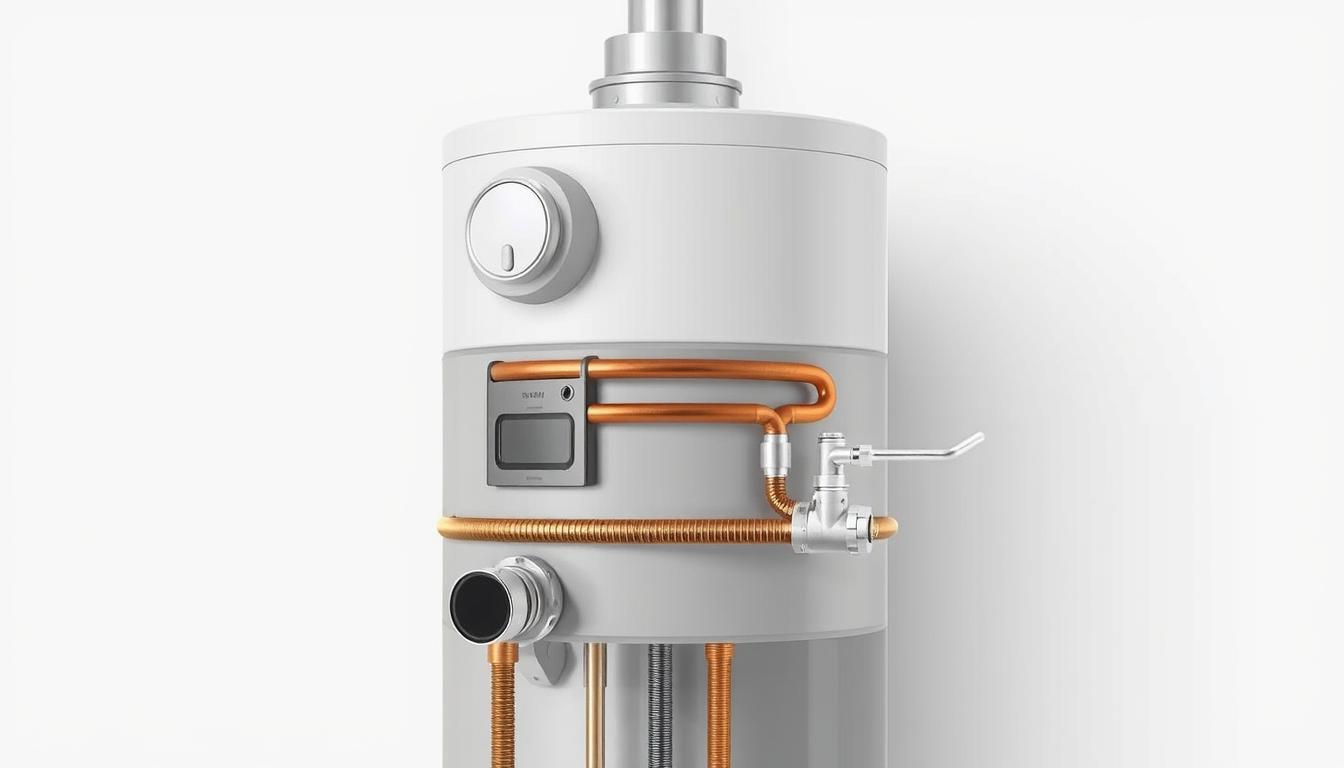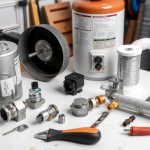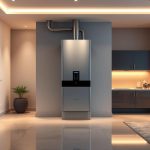Last winter, my family’s water heater broke down, leaving us cold and upset. This experience taught me how vital it is to know about hot water heater parts and components. It showed me how important it is to understand our home’s systems.
Water heaters work quietly behind the scenes, giving us hot water for everyday needs. Knowing how to maintain them can prevent sudden failures and expensive fixes. These systems are more complex than many think, with tank sizes from 20 to 80 gallons and advanced heating systems.
Whether you have an electric, gas, or tankless water heater, knowing its parts is key. It lets you spot problems fast and keep your water heater running well. Each part is essential for providing hot water to your home.
Key Takeaways
- Water heaters come in various tank sizes to meet household needs
- Understanding components helps prevent unexpected breakdowns
- Regular maintenance extends water heater lifespan
- Different types of water heaters have unique component configurations
- Knowledge of parts can help reduce repair costs
Understanding Hot Water Heater Systems

Choosing the right water heater is key for comfort and saving energy at home. Today, homeowners have many options. Each type has its own benefits and features.
Water heater technology has grown a lot. This gives homeowners many choices for their heating needs. The main types are:
- Gas water heater
- Electric water heater
- Tankless water heater
Exploring Water Heater Types
Each type of water heater has its own strengths. Gas water heaters are loved for their fast heating and cost savings. They use natural gas or propane to heat water quickly and well.
Electric water heaters offer steady performance with electrical heating. They’re great for homes with reliable electricity. They’re also good for the planet if powered by green energy.
“Tankless water heaters represent the future of home water heating, delivering hot water on demand without constant energy consumption.”
How Water Heaters Function
Water heaters work in different ways, depending on their type. Tankless water heaters heat water right away as it flows. This means no need for a big tank and less energy waste. Plus, they give endless hot water.
When picking a water heater, think about your home’s size, energy use, and setup costs. Keeping your water heater in good shape helps it last longer and work better.
With the right care, modern water heaters can last 10-20 years. This makes them a big investment in your home’s comfort and efficiency.
Key Components of Hot Water Heaters
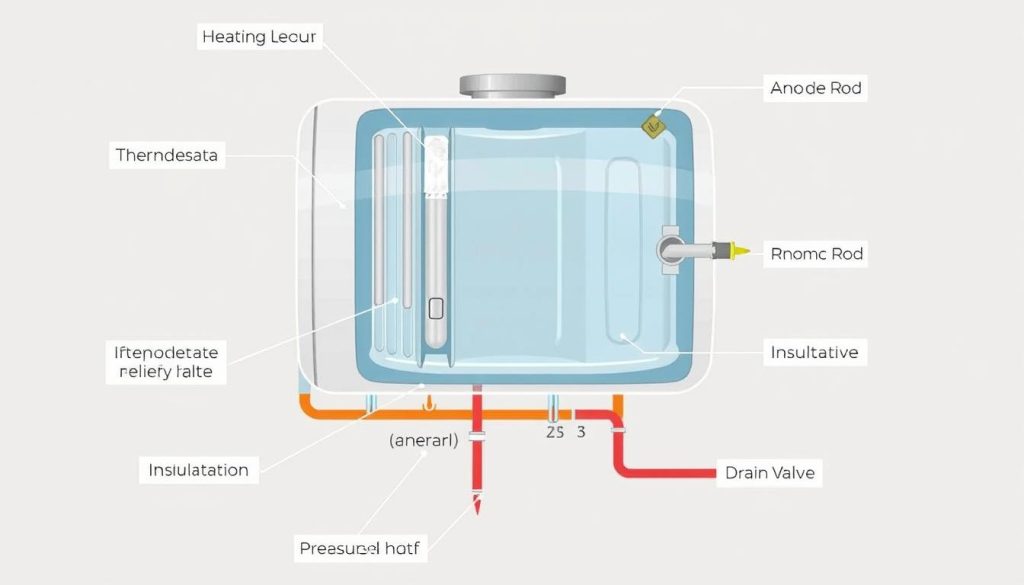
Water heaters have important parts that work together. They provide hot water for homes. Knowing these parts helps homeowners fix and keep their water heaters working well.
Storage Tanks
The water heater tank holds hot water. It comes in sizes from 40 to 120 gallons. The most common sizes are 40, 50, and 80 gallons. Modern tanks are made from:
- Glass-lined steel for corrosion resistance
- Stainless steel for durability
- Advanced composite materials
Heating Elements
Heating elements turn cold water into hot water. Water heaters use different ways to heat water:
| Heater Type | Heating Method | Recovery Time |
|---|---|---|
| Electric Water Heaters | Electrical resistance elements | Approximately 2 hours |
| Gas Water Heaters | Gas burners | Approximately 1 hour |
| Oil-Fired Water Heaters | Oil combustion | Approximately 1 hour |
Thermostats
The thermostat controls water temperature. Electric models have adjustable thermostats. Gas models might have manual or electronic controls.
“A well-functioning thermostat ensures consistent water temperature and energy efficiency.”
Thermostats keep water between 120-140 degrees Fahrenheit. This prevents scalding and saves energy.
- Electric water heaters often have multiple thermostats
- Gas water heaters use specialized temperature regulation systems
- Digital thermostats offer more precise temperature control
Regular maintenance of these key components ensures optimal water heater performance and longevity.
The Role of an Anode Rod

Water heaters are complex systems that need special parts to last long and work well. The anode rod is a key part in keeping your water heater in good shape and preventing corrosion.
The anode rod acts as a protector for your water heater tank. It’s important to check it every one to three years to keep your water heater safe from corrosion.
Understanding Corrosion Protection Mechanisms
Anode rods protect your water heater tank through a special electrochemical process. Made from magnesium or aluminum, they draw corrosive particles away from your tank.
- Magnesium anode rods offer superior protection for most water conditions
- Aluminum rods work best in hard water environments
- Powered anode rods provide advanced long-term protection
“The sacrificial anode ‘sacrifices’ itself to extend the life of the water heater.” – Water Heater Maintenance Experts
Choosing the Right Anode Rod
Choosing the right anode rod depends on water quality and tank size. Prices range from $20 to $40 for standard rods. Specialized rods are available for larger or unique tanks.
Experts say picking the right anode rod can greatly extend your water heater’s life. It’s a smart investment for your home.
Water Heater Insulation

Keeping your water heater insulated is key for homeowners wanting to save on energy and cut down on bills. Insulation helps keep the heat in and makes your system work better.
Benefits of Proper Insulation
Insulating your water heater brings many benefits:
- Reduces standby heat loss by up to 45%
- Decreases energy consumption
- Lowers monthly utility bills
- Extends water heater lifespan
- Improves overall energy efficiency
Practical Insulation Tips
Here are some effective ways to insulate your water heater:
- Use an insulation blanket for older water heater models
- Check existing insulation thickness (recommended R-value of R-12 to R-25)
- Seal any air gaps around the tank
- Inspect insulation annually for wear or damage
“Proper insulation can save homeowners up to 16% on water heating costs annually.” – Energy Star Research
By using smart insulation, you can make your water heater work better. This not only cuts down on energy use but also helps keep your heating system in top shape.
Valves in Hot Water Heaters

Water heater valves are key to keeping your home’s hot water safe and working right. They make sure everything runs smoothly, avoid dangers, and help with upkeep.
Today’s water heaters have two main valves: the pressure relief valve and the drain valve. Knowing about these valves helps homeowners take care of their systems well.
Pressure Relief Valve: Your Safety Guardian
The pressure relief valve is a vital safety feature for water heaters. It stops the tank from getting too full by letting water out when pressure gets too high.
- Prevents tank explosions
- Maintains safe operating pressure
- Protects against system failures
Pressure Relief Valve Configurations
| Valve Type | Size | Pressure Setting | Price |
|---|---|---|---|
| Standard Pressure Relief | 3/4″ | 150 psi | $11.93 |
| Adjustable Pressure Valve | 3/4″ | 50-175 psi | $144.24 |
Drain Valve: Essential for Maintenance
The drain valve at the water heater’s bottom is key for upkeep. It lets homeowners drain out sediment, which keeps the heater working better and lasts longer.
“Regular maintenance through the drain valve can significantly improve your water heater’s performance and longevity.” – Plumbing Experts
Brands like Camco and Bradford White make top-notch water heater valves. When picking new parts, make sure they fit your water heater model and system needs.
Electrical Components of Hot Water Heaters
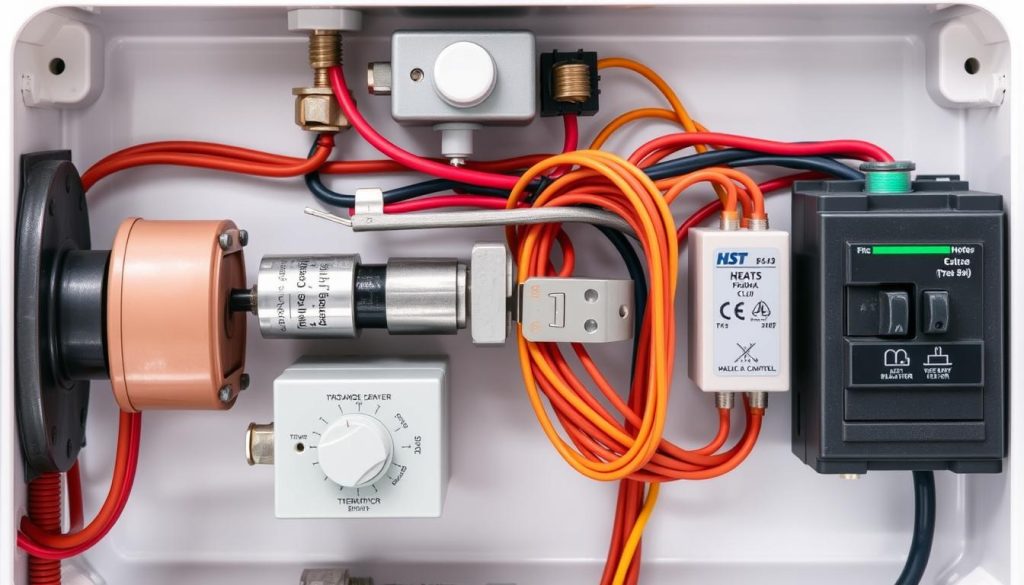
Electric water heaters use special electrical parts to work safely and efficiently. Knowing about these parts helps homeowners keep their systems running well. It also helps avoid electrical problems.
Circuit Breaker Protection
Circuit breakers are key in keeping electric water heaters safe. They cut off power when:
- Too much current flows
- Short circuits happen
- Electrical dangers are found
Wiring and Electrical Connections
Good wiring is vital for electric water heater components to work right. Homeowners need to know about electrical connections:
| Electrical Component | Function | Maintenance Requirement |
|---|---|---|
| Heating Elements | Make water hot | Check resistance often |
| Thermostat | Controls water temperature | Check once a year |
| Circuit Breaker | Prevents too much power | Check often |
“Electrical safety is not an option, it’s a necessity in water heater maintenance.” – Professional Plumbing Expert
When working with electric water heater wiring, safety comes first. Wrong installations or damaged wiring can cause big risks. These include electrical fires and system failures.
Safety Recommendations
- Always turn off power before fixing things
- Use the right wire sizes for your heater
- Make sure all connections are tight and clean
- Get a pro for complex electrical jobs
Keeping electrical parts in good shape can make your electric water heater last longer. It also stops sudden breakdowns.
Gas Components in Hot Water Heaters

Gas water heaters need special parts to work safely and well. Knowing about the gas system helps homeowners keep their water heaters in good shape. It also helps spot problems early.
Gas Valves: The Control Center
The gas valve is key for controlling gas water heater parts. It controls gas flow to the burner and keeps things safe. Today’s gas valves have cool features like:
- Automatic shut-off
- Temperature control
- Safety checks
Exploring Venting Systems
A good venting system is vital for gas water heaters. It gets rid of harmful gases safely. This keeps the heater working right.
| Venting Component | Primary Function |
|---|---|
| Flue Baffle | Directs exhaust fumes to vents |
| Vent Pipe | Removes combustion gases safely |
| Blower Assembly | Pushes gases out in power vent models |
“Proper installation and maintenance of gas components are key for water heater safety and efficiency.” – Heating Systems Expert
Parts like the gas valve and venting system make sure you have hot water. Homeowners should check these parts often. They should also get help from experts for big maintenance jobs.
Maintenance Parts for Hot Water Heaters
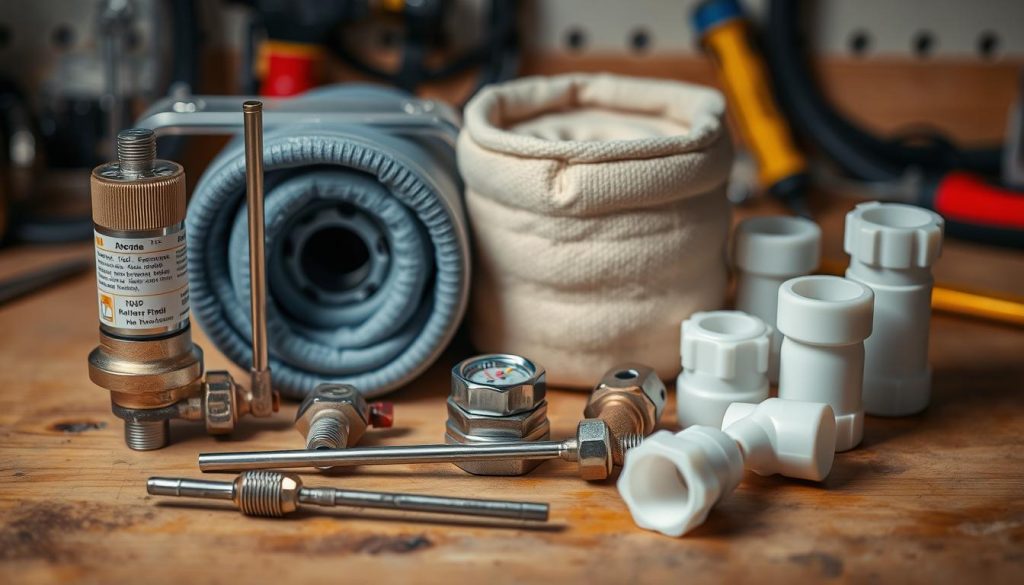
Keeping your water heater in good shape is key to a long-lasting and efficient hot water system. Homeowners and technicians agree that regular care can save you from expensive repairs. It also helps your water heater last longer.
To protect your water heater, you need a solid maintenance plan. This plan should include important replacement parts and cleaning supplies. Experts say a good maintenance strategy covers both preventive care and replacing parts when needed.
Essential Replacement Filters
Good water heater maintenance starts with quality replacement filters. These filters are great at removing sediment and minerals. They keep your water clean and prevent damage to your system.
- Sediment filters for removing particles
- Specialized filters for hard water areas
- Annual replacement recommended
Professional Cleaning Supplies
Choosing the right cleaning supplies is key for water heater care. Different water heaters need different cleaning methods to avoid corrosion and keep working well.
| Cleaning Supply | Purpose | Recommended Frequency |
|---|---|---|
| Descaling Solution | Remove mineral buildup | Annually |
| Rust Inhibitor | Prevent corrosion | Every 2 years |
| Anode Rod Cleaner | Maintain protective rod | During annual inspection |
“Consistent maintenance is the key to extending your water heater’s operational life and efficiency.” – HVAC Maintenance Professionals
Experts suggest having a stock of replacement parts and cleaning supplies from trusted brands like A.O. Smith, Bradford White, and Baxi. Always check your water heater’s manual for the best maintenance tips.
- Stock essential replacement parts
- Use manufacturer-recommended cleaning supplies
- Schedule regular professional inspections
Common Replacement Parts

Water heater maintenance is key to keeping your hot water flowing. Knowing the important parts to replace is essential. Homeowners and technicians often need to swap out parts to keep systems running well.
Knowing when to replace key parts can prevent sudden failures. It also helps your water heater last longer. Let’s look at the most common parts every homeowner should know.
Heating Element Replacement
The heating element is vital in electric water heaters. It usually lasts 10-15 years and costs $23-$50. You’ll need to replace it if:
- Water doesn’t heat up right
- You hear strange noises from the tank
- Water temperature drops a lot
Thermostat Replacement
Thermostats control water temperature. They’re key for steady hot water. Look out for these signs of failure:
- Water temperature is all over the place
- No hot water at all
- Temperature keeps changing wildly
Thermostat replacements cost between $17 and $30, depending on your water heater.
Anode Rod Replacement
The anode rod fights off corrosion. It’s vital for your tank’s health. Experts say to check it every three to five years.
| Replacement Part | Average Cost | Replacement Frequency |
|---|---|---|
| Heating Element | $23-$50 | Every 10-15 years |
| Thermostat | $17-$30 | As needed |
| Anode Rod | $30-$50 | Every 3-5 years |
“Regular maintenance of water heater replacement parts can save homeowners significant repair and replacement costs in the long run.”
Always check your water heater’s manual. If unsure, get professional help. This ensures the parts are installed right for best performance.
Troubleshooting Hot Water Heater Issues
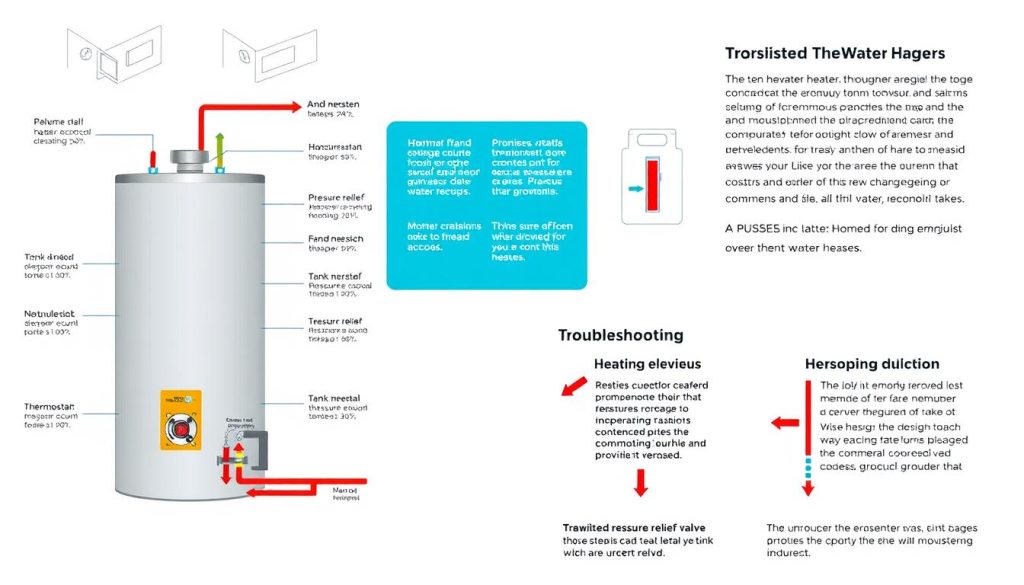
Dealing with water heater problems can be tough for homeowners. Knowing the signs of trouble and when to call a pro can save you money and time. It also helps avoid damage to your water heater.
Signs You Need New Parts
Spotting early signs is key for keeping your water heater in good shape. Here are some signs that your water heater might need repairs or new parts:
- Insufficient hot water production
- Unusual banging or crackling sounds
- Rust-colored or discolored water
- Water temperature inconsistencies
- Visible leaks around the tank
About 60% of water heater problems can be fixed by replacing specific parts. This includes issues with the thermostat, heating element, or sediment buildup.
When to Call a Professional
Some problems need a pro’s help. Issues with electrical parts, gas systems, or big leaks are best left to experts.
| Issue Type | DIY Possible | Professional Recommended |
|---|---|---|
| Thermostat Adjustment | High | Low |
| Gas Control Valve Replacement | Low | High |
| Electrical Heating Element | Medium | Medium |
| Major Tank Leakage | Low | High |
Call a pro when:
- Your water heater is over ten years old
- Basic fixes don’t solve the problem
- Gas or electrical connections look bad
- It needs complex system checks
“Regular maintenance can make your water heater last up to 50% longer,” say experts.
Regular upkeep, like flushing the tank and checking parts, can prevent big problems. It also cuts down on the need for costly repairs.
Tools for Hot Water Heater Repair
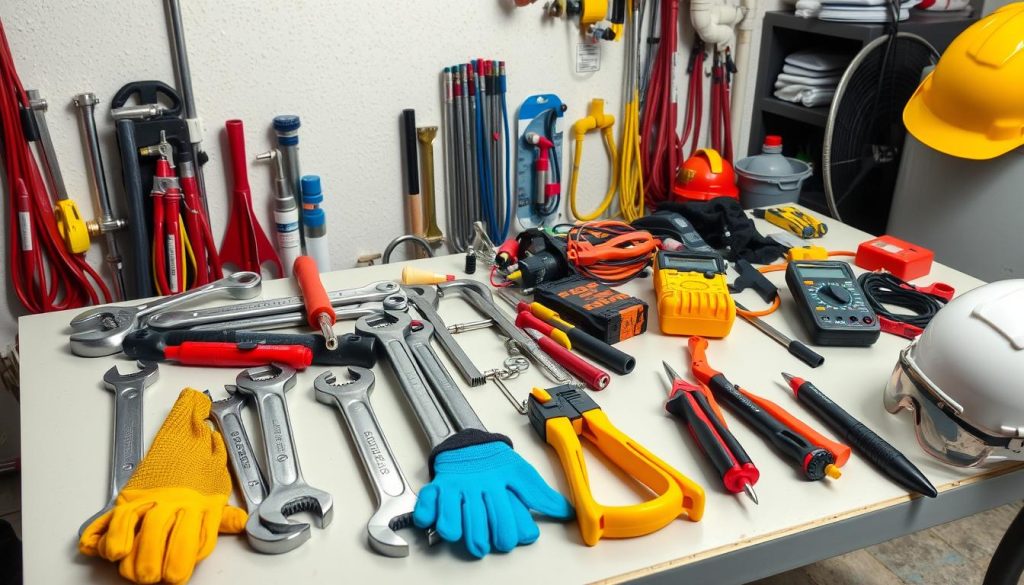
Fixing water heaters needs a smart plan and the right tools. DIY fans should have a full toolkit for safe and effective fixes. Knowing the key tools makes fixing your water heater a doable home job.
Essential Tools for DIY Repairs
For top-notch water heater fixes, you need specific tools. These tools ensure your repairs are precise and safe. Here are the must-haves for DIY success:
- Multimeter for electrical checks
- Insulated screwdrivers in different sizes
- Non-contact circuit tester
- Adjustable wrench and socket set
- Garden hose for draining
- Pipe wrench
Safety Equipment for Water Heater Maintenance
When you’re doing DIY repairs, safety comes first. Important safety gear keeps you safe from dangers:
| Safety Item | Purpose |
|---|---|
| Insulated Gloves | Protect against electrical and thermal risks |
| Safety Glasses | Shield eyes from debris and possible splashes |
| Gas Leak Detector | Find gas leaks in gas water heaters |
| Flashlight | Light up tight spots during checks |
“Always put safety first when working with water heaters. The right tools help, but safety gear is essential.” – Professional Technician
Brands like Camco and Bradford White suggest using tools made for water heater care. Make sure your tools fit your electric or gas water heater to avoid damage.
Always turn off power before starting any DIY fix. For tricky problems or doubts, it’s best to call a pro for water heater upkeep.
Hot Water Heater Accessories

Water heater accessories are key to keeping your home’s water heating system running well. They boost efficiency, extend the system’s life, and protect your investment.
Water Softener Systems
A water softener is a must-have accessory. It fights mineral buildup in your system. These systems remove hard water minerals like calcium and magnesium, which can harm your water heater.
- Reduces scale buildup in pipes and tanks
- Increases overall water heater efficiency
- Extends the lifespan of water heating equipment
Expansion Tanks
Expansion tanks are vital for your water heater and plumbing system. They handle pressure changes, preventing damage to pipes and connections.
| Accessory | Primary Function | Benefits |
|---|---|---|
| Expansion Tank | Pressure Regulation | Prevents water hammer, reduces pipe stress |
| Water Softener | Mineral Removal | Improves water quality, prevents scale |
“Accessories can transform a standard water heater into a more efficient and long-lasting system.” – Plumbing Experts
Brands like Camco and Bradford White make reliable water heater accessories. Quality accessories can save homeowners a lot of money on maintenance and replacements.
Energy-Efficient Parts for Hot Water Heaters
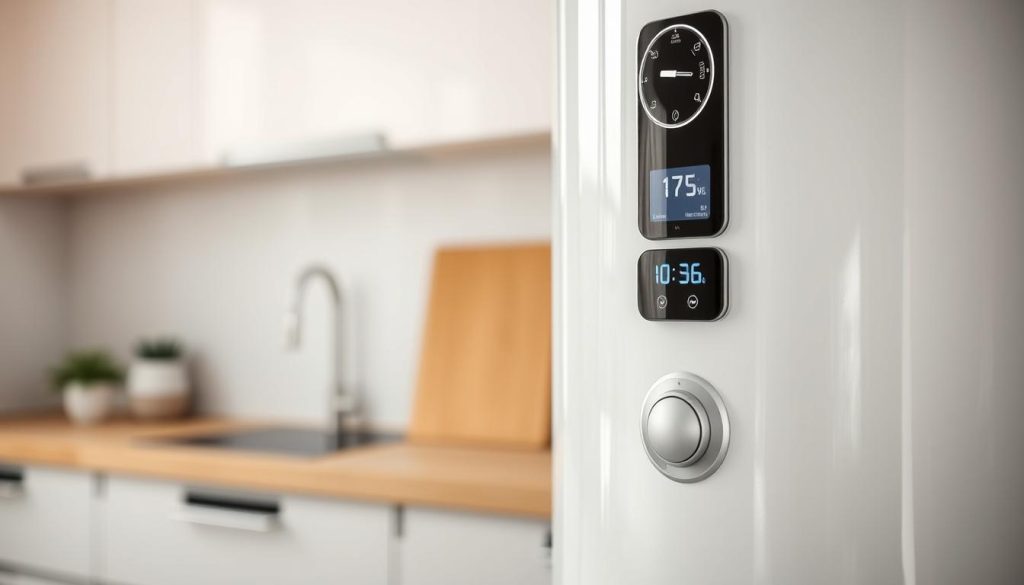
Upgrading your water heater can cut down on energy use and lower bills. New, energy-saving water heater tech offers smart ways to reduce waste. It keeps your system running well.
Energy-Saving Features to Consider
Choosing the right parts can make your water heater better. Look for:
- Advanced heating elements
- Smart temperature control
- Integrated insulation
- High-efficiency burners for gas models
Upgrading to Efficient Components
Tankless water heater parts are a top choice for saving energy. They offer big advantages:
- Less energy waste when not in use
- Save space with their design
- Can last up to 20 years
- Save money over time
Investing in energy-saving features is not just about reducing bills—it’s about creating a more sustainable home environment.
Parts like heat exchangers, control boards, and flow sensors boost efficiency. Brands like Bradford White make reliable, high-quality parts for better performance.
When looking at upgrades, check if they fit your system and save energy. The right parts can save you money and help the planet.
Ensuring Regulatory Compliance
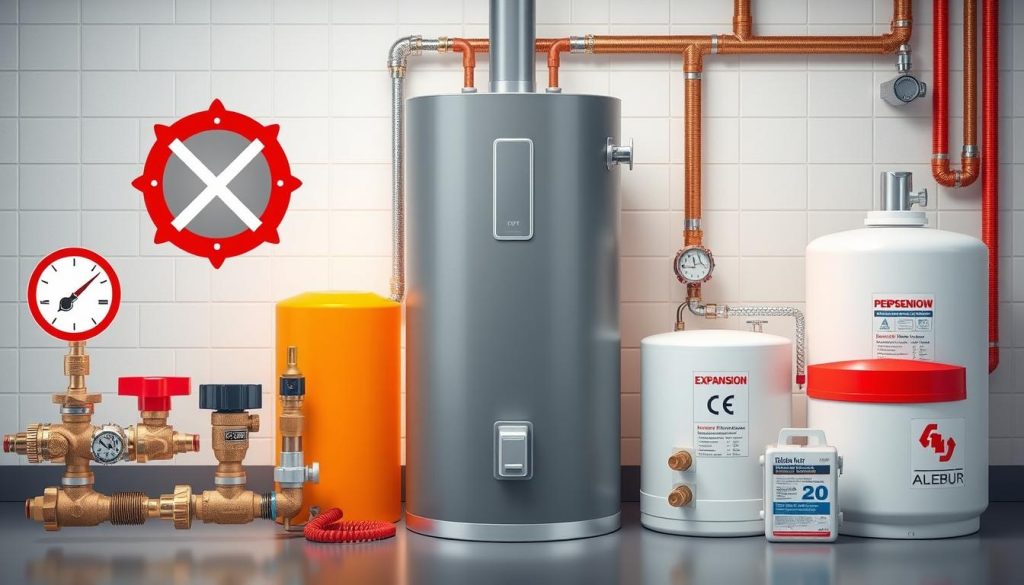
For homeowners, dealing with water heater rules can be tricky. Safety standards and local codes are key to right installation and upkeep of water heating systems.
The U.S. Department of Energy (DOE) set up detailed rules for better water heater safety and energy use. These rules affect both home and business water heating setups.
Understanding Local Codes
Local building codes have specific rules for water heater setup and use. Important points include:
- Minimum clearance needs
- Ventilation rules
- Standards for electrical and gas connections
- Rules for safety valve placement
Safety Standards for Components
Water heater safety rules demand strict testing and approval for key parts. The National Fuel Gas Code (NFGC) outlines detailed guidelines for water heater setups.
| Component | Safety Requirement | Regulation Standard |
|---|---|---|
| Temperature Controls | Maximum 140°F | Burn Prevention |
| Pressure Relief Valve | Right Discharge Specs | ANSI Z21.10.1 |
| Venting System | Clearance from Flammable Stuff | 6-inch Single Wall, 1-inch Double Wall |
“Following water heater rules is more than just following rules—it’s about keeping your home and family safe.” – Home Safety Expert
Homeowners should talk to local officials or certified pros to make sure they meet all water heater rules, safety standards, and local codes.
Ordering and Purchasing Parts
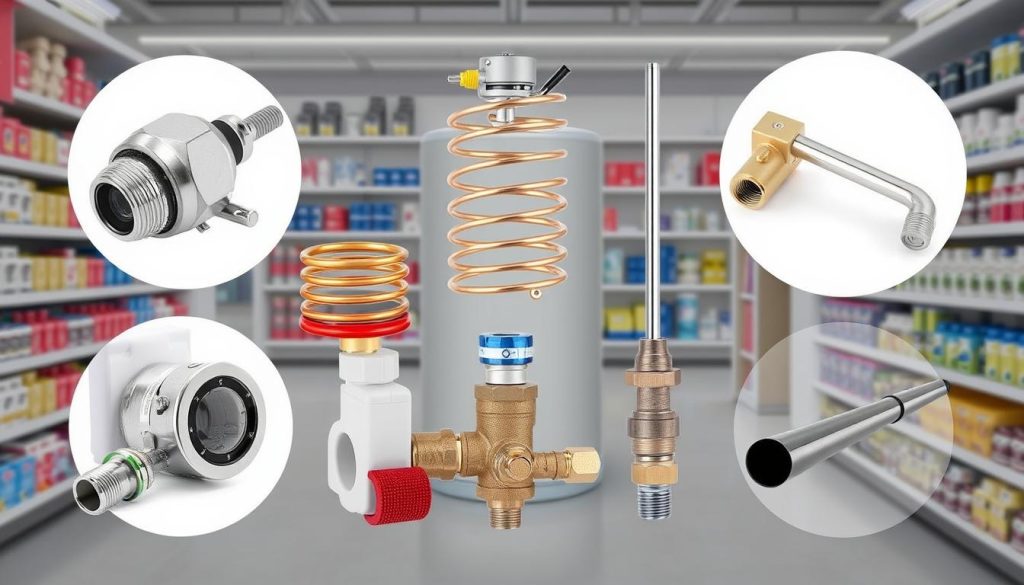
Finding the right water heater parts can be tough for homeowners and DIY fans. It’s important to do your homework and plan carefully.
Choosing the right parts for your water heater is key. The most important thing is to make sure the parts fit your system.
Top Sources for Water Heater Parts
- Online specialized retailers
- Home improvement stores
- Manufacturer direct websites
- Professional plumbing supply shops
Key Factors When Buying Replacement Parts
- Verify exact model number compatibility
- Check manufacturer warranty
- Compare pricing across multiple suppliers
- Evaluate component quality
| Brand | Part Availability | Average Price Range |
|---|---|---|
| Bradford White | Extensive | $50-$250 |
| Rheem | Comprehensive | $40-$220 |
| AO Smith | Wide Selection | $45-$235 |
“Always prioritize genuine manufacturer-approved parts to ensure optimal performance and system longevity.”
Getting help from customer service can be very helpful. They can guide you to the right parts for your water heater. Suppliers like PlumbersStock offer great support through different ways to contact them.
Pro Tip: Always check the part details before you buy. Parts for electric and gas water heaters are not the same and can’t be swapped.
Conclusion: Maintaining Your Hot Water Heater
Keeping your hot water heater in good shape is key to a long-lasting and efficient system. Regular care can add years to your water heater’s life, saving you money on replacements. Just 1-2 hours a year of basic upkeep can keep your hot water flowing smoothly.
Regular Maintenance Tips
Sticking to a maintenance routine is essential for your water heater’s health. Flush the tank once a year to clear out sediment. Also, check the anode rod every 3-5 years and replace it if it’s corroded.
Keep the thermostat at 120 degrees Fahrenheit. This is safer and can cut your energy costs by up to 5%.
Benefits of Keeping Parts in Good Condition
Good maintenance can make your water heater last up to 15 years, instead of the usual 8-10. Insulating pipes and the tank can cut down on heat loss by up to 45%. This can save you 9% on water heating costs.
By being proactive with inspections and leak checks, you avoid expensive repairs. This ensures your home always has hot water.
